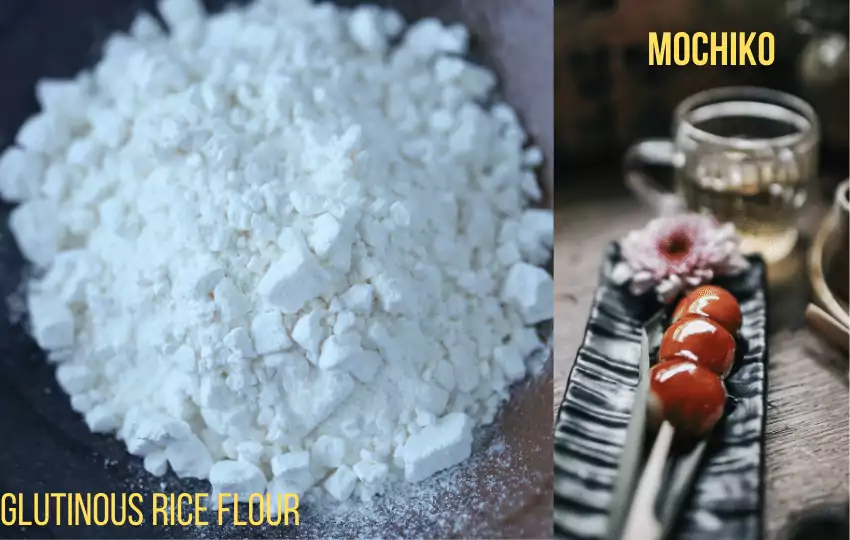Mochiko flour and glutinous rice flour are both used in Asian cuisine, but what is the difference between glutinous rice flour vs mochiko flour?
Glutinous rice flour is made from short-grain white rice and has a higher starch content than mochiko flour. This gives glutinous rice flour a denser texture and a more sticky consistency.
Mochiko flour is made from long-grain white rice and has a lower starch content than glutinous rice flour. This gives mochiko flour a lighter texture and mouthfeel. Both flours can be used to make doughs, batters, and sauces. You can know more related flour differences like – Oats Flour VS Almond Flour
What is glutinous rice flour?
Glutinous rice flour is made from glutinous rice, which is also known as sticky, waxy, or sweet rice. Glutinous rice is a variety of rice cultivated primarily in Southeast and East Asia, including Bhutan and Northeastern India.
Glutinous rice contains a very low amount of amylase and a high amount of Amylopectin, which is responsible for the sticky quality of glutinous rice and has sticky in nature which is a significant characteristic of Glutinous rice. It is sweet in taste.
It is commonly consumed throughout Asia. Most people believe that glutinous rice or its flour contains gluten, as its name suggests, but it is wrong, and there is no gluten present in glutinous rice flour.
The rice grains are glue-like sticky, which is why it is called glutinous rice. The main species is Oryza sativa var. glutinosa.
Glutinous rice flour is widely accessible in most grocery stores and comes in various brands. It’s an Asian classic cherished by chefs of different cuisines.
It is used to make different confections and glutinous rice cakes. In China, it is used to make the new year cake known as Nian Gao, sweet-filled dumplings, Various dim sum, and Rice cakes.
In Korea, Glutinous rice flour is used to make kimchi, added to gochujang ( Korean red chili paste), Rice cake, etc.
In Japan, it is used to make mochi, wagashi, etc.
Besides this, glutinous rice flour is used to make desserts, different sweet snacks, Javanese cake, and so on… Also, Glutinous rice flour is utilized similarly to cornstarch, potato starch, or arrowroot powder.
What is Mochiko Flour?
Mochiko flour is a type of glutinous rice flour, but the preparation is different from normal glutinous rice flour.
Mochiko flour or Mochigomeko is prepared by ground cooked mochigome, a type of japonica glutinous short-grain rice.
Mochigome, the second most popular sticky rice type, lack amylose while high in amylopectin, which gives the rice its sweet and sticky nature.
Mochiko or Shiratamako flour is mainly produced to make Mochi. But there is a slight distinction between them- the texture and way of processing.
Shiratamako is more fine, refined, and elastic than mochiko flour. Mochiko is coarser and more chewy and sticky than shiratamako.

The main use of mochiko flour is Mochi, a worldwide famous Japanese rice cake; it is a traditional Japanese food in Japan, specially meant for celebrating New year.
Other ingredients may contain sugar, cornstarch, and water, also available in different flavors and with various stuffing.
Mochiko rice flour is only used in making dessert, ice cream, rice pudding, rice cakes, plum cake, and rice mouse.
Read More- Know how to make Mochi without Mochiko rice flour
Glutinous Rice Flour VS Mochiko Flour- Best way to use
Glutinous rice flour and Mochiko flour are both flours made from glutinous or sticky rice. These two flours have many similarities but also some important differences.
The main difference between glutinous rice flour and Mochiko flour is the way they are made. Glutinous rice flour grids whole glutinous rice grains into a fine powder. Mochiko flour, on the other hand, is made by soaking glutinous rice in water until it breaks down into a sticky paste, which is then dried and ground into a powder.
Another difference between these two flours is their texture. Glutinous rice flour has a wonderful, powdery texture, while Mochiko flour has a slightly coarser, grainy texture.
Finally, there is a price differential between these two kinds of flour. Glutinous rice flour is generally more expensive than Mochiko flour.
So, what is the difference in making process, uses, texture, and price between glutinous rice flour and Mochiko flour?
The main difference is in the way they are made; glutinous rice flour is made by grinding whole glutinous rice grains into a fine powder, while Mochiko flour is made by soaking glutinous rice in water until it breaks down into a sticky paste, which is then dried and ground into a powder.
Another difference between these two flours is their texture; glutinous rice flour has a very fine, powdery texture, while Mochiko flour has a slightly coarser, grainy texture.
Finally, there is also a difference in price between these two types of flour; glutinous rice flour is generally more expensive than Mochiko flour.
Uses: Glutinous rice flour is commonly used in Asian desserts and sweets, such as dumplings, cakes, and noodles.
Mochiko flour is also often used in Japanese sweets and snacks, such as mochi balls and daifuku. Texture: Glutinous rice flour has a very fine, powdery texture.
Mochiko flour has a slightly coarser, grainy texture. Price: Glutinous rice flour is generally more expensive than Mochiko flour.
Read More- Best Rice Flour Substitute for Kimchi
FAQs
Q1. Is rice flour and glutinous rice flour the same?
Rice flour and glutinous rice flour are not the same. Glutinous rice flour is made from sticky or glutinous rice, while regular rice flour can be made from any type of rice. Glutinous rice flour is used to make dishes like mochi and dumplings, while regular rice flour is often used in baking or as a thickener for soups and sauces.
Q2. Is mochiko synonymous with sticky rice flour?
Mochiko and glutinous rice flour are both made from glutinous rice but differ in texture and flavor. Mochiko is a fine, powdery flour with a chewy texture. In contrast, glutinous rice flour is more coarse and produces a stickier dough. While they can be substituted in some recipes, the outcome will not be the same.
Q3. Can I replace mochiko with glutinous rice flour?
Yes, you can replace mochiko with glutinous rice flour in most recipes. The two ingredients are very similar and will produce chewy, sticky results. However, glutinous rice flour is slightly finer than mochiko, so your final product may be a little smoother if you use it instead.
Q4. Is glutinous rice the same as mochi rice?
No, glutinous rice is not the same as mochi rice. Glutinous rice is a type of rice that is sticky and chewy, while mochi rice is a type of rice that is used to make mochi, which is a Japanese dessert.
Q5. Can I use Thai glutinous rice flour for mochi?
Yes, you can use Thai glutinous rice flour to make mochi. The flour is readily available at Asian markets and online retailers.
Follow the recipe below to make delicious mochi at home.
Ingredients:
-1 cup Thai glutinous rice flour
-1 cup water
-1/4 cup sugar
-1 teaspoon baking powder
Instructions:
1. Whisk together the glutinous rice flour, water, sugar, and baking powder in a bowl.
2. Place the mixture in a steamer basket and steam for 15 minutes.
3. Remove the mochi from the steamer and let it cool slightly before shaping it into balls or other desired shapes.
If you want a more traditional mochi flavor, add 1 teaspoon matcha powder to the mixture before steaming. This will give the mochi a lovely green color and a slightly bitter taste that contrasts nicely with the sweetness of the sugar. Enjoy!

